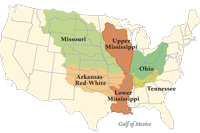
Image: nature.org
Since 1995, Thomas (Tom) Avellino of New Jersey has served as an investor, limited partner, and managing general partner with several private investment partnerships. Also active in charitable giving, Thomas Avellino supports several nonprofit organizations, such as the Nature Conservancy, through his family foundation.
The Nature Conservancy is working to address the Gulf of Mexico’s “dead zone,” an area of oxygen-depleted water that makes it difficult for marine life to thrive. The result of nutrient runoff, the dead zone extends from the coast of Texas to the Mississippi River Delta in Louisiana.
Normally, the dead zone in the Gulf of Mexico covers an average of 5,309 square miles, but it has expanded to cover 8,776 square miles, or approximately the size of New Jersey. The cause of this expansion is likely the heavy spring rains, which pushed an excessive amount of nitrates from cities, farms, and other sources into the Mississippi River Basin’s waterways, which empty into the Gulf. As the dead zone destroys marine life, the economic consequences are far-reaching, especially for fishermen and others working in the seafood industry.
To address this issue, the Nature Conservancy is working with government bodies and farmers to find ways to prevent nutrients from leaving farmland. The organization seeks to curb runoff through better farming practices such as reduced tillage, crop rotation, use of cover crops, and nutrient management.
One specific area where the Nature Conservancy is working is in the Wabash River of Indiana and Illinois. The tributary is responsible for a particularly high discharge of nitrogen into the Gulf. Working with the US Department of Agriculture’s Natural Resources Conservation Service, the Nature Conservancy has helped restore or protect 44,000 acres of floodplain habitat near the Wabash River, with the ultimate goal of restoring or protecting 10,000 more acres by 2022.



You must be logged in to post a comment.